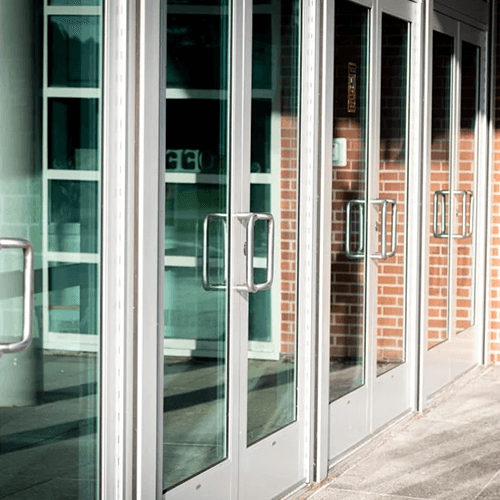
Commercial doors aren’t exactly the hottest topic. For instance, there’s never been a blog about doors that will “break the internet,” and there probably never will be. Unless, of course, this is that blog, in which case you saw it here first. Here are a few fun facts about commercial doors that you probably don’t know:
If you had three guesses to determine where the largest doors in the world are, you might be able to get this one right with little to no assistance. They belong to NASA. You probably saw that coming, and now you’re probably also imagining an Artemis rocket coming out of the hangar and rolling to the launchpad.
NASA’s big doors stand 456 feet high. For comparison, three times as tall as the Statue of Liberty. These doors are located at the Kennedy Space Center. Opening or closing takes about 45 minutes, so bring a snack if you plan to watch.
We take for granted these days that commercial doors all have sleek and sturdy pulls, knobs, or crash bars as their hardware. Before 1878, this was not the case. Most doors were opened with a string, a bespoke handle made of wood, or even by sticking your finger into a knothole.
Thanks to Osbourn Dorsey, we now have a reliable and standard door-locking mechanism, relatively unchanged since his 1878 patent.
Thankfully, egress in commercial spaces today is much easier (and safer), thanks to crash bars and regular old door knobs.
When you walk up to a commercial building, you’ll see signs on the doors instructing you to either push or pull to gain access. There is a good reason for a door that’s marked “PUSH,” and it has to do with security.
The reason revolves around hinge design and technology. Barrel hinges, typical in some commercial applications but also in residential doors, are usually mounted at the top, middle, and bottom of a door. The barrel where the hinge pin is installed is on the same side the door swings toward.
If a commercial door with this style of hinge were to swing outward, the hinge pins would be exposed on the exterior of the building. All an intruder would need to be able to break in is a hammer and punch. They could drive the hinge pins out, lift the door from its mounting, and gain access in less than a minute.
Theophilus Van Kannel patented a triple-paneled revolving door on August 7, 1888, around ten years after Dorsey's doorknob patent.
A clever feature of revolving doors is their function as an airlock, making them popular on skyscrapers' street fronts. Large buildings experience varying atmospheric pressure due to cooler (denser) air in summer and warmer air in winter.
Revolving doors reduced pedestrian congestion and improved commercial air conditioner efficiency.
At CDF Distributors, we ship thousands of commercial doors and hardware daily directly to job sites or your location. Ordering is easy, customization is quick, and you can even get instant quotes online. Try our online tool, Pro Builder, for yourself today, and see how easy it is to work with the best commercial door supplier.